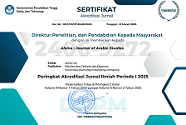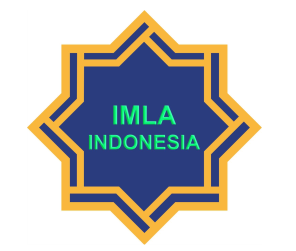Taṭwīru Mādah al-Lughah al-‘Arabiyyah ‘ala Asāsi al-Ta‘allum al-Ta‘āwuni
DOI:
https://doi.org/10.21580/alsina.2.1.5455Keywords:
Arabic teaching material, cooperative learning, read-ing skillAbstract
Learning Arabic in MTs Unggulan Hikmatul Amanah in Amanatul Ummah Islamic Boarding School really noticed a reading skill in the learning process, so that the students would be able to read Islamic religion literature written in Arabic language. This study aimed to describe developing process of Arabic language teaching material with Cooperative Learning approach for 7th grade students MTs Unggulan Hikmatul Amanah and to know a validity and also an effectiveness of the teaching material. Type of this study used developing steps by Borg and Gall in Sugiono’s book. Data in this study, had qualitative and quantitative. It was collected with interviews, questionnaire and tests. Meanwhile, the data was analyzed descriptively and T test. The results of this study indicate that the teaching materials developed are appropriate and effective for teaching Arabic at this level after going through a process of improvement based on expert judgment and field trials.
Downloads
References
ابن منظور. لسان العرب، المجلد السادس. القاهرة ، دار المعارف، ١١١٩.
الحسن، حسن عبد الرحمن. دراسات في المناهج وتأصيلها، مذكرة الدورة التدريبية لمعلمي اللغة العربية في البرنامج الخاص، د.ن، مؤسسات الوقف الإسلامي، 1424ه.
الدليمي، طه علي حسين، وسعاد عبد الكريم الوائلي. اللغة العربية مناهجها وطرائق تدريسها. القاهرة، دار الشروق، ٢٠٠٥.
_______، اتجهات حديثة في تدريس اللغة العربية. عمان-الأردن: جدار الكتاب العالمي، 2009.
سعدات، محمود فتوح محمد، وهيا تركي معدي الحربي. استخدام إستراتيجية التعلم التعاوني في إدارة القاعة الدراسية. تابع الجديد والحصري على شبكة الألوكة www.alukah.net.
شحاتة، حسن. تعليم اللغة العربية بين النظرية والتطبيق. مصر: الدار المصرية اللبنانية، دون سنة.
طعيمة، رشدي أحمد. مناهج تدريس اللغة العربية بالتعليم الأساسي. القاهرة، دار الفكر العربى، ١٩٩٧.
_______، تعليم اللغة العربية لغير الناطقين بها مناهجه وأساليبه. مصر: جامعة المنصورة، دون السنة.
فطاني، محمد يانس. تنمية مهارة القراءة بطريقة التعلم التعاوني (البحث الإجرائي في الفصل الأول بالمدرسة الثانوية الإسلامية الحكومية عارمبي-عاوي)، جامعة مولانا مالك إبراهيم الإسلامية الحكومية بمالانج، رسالة الماجستير، غير منشور، 2008.
كوجك، كوئر حسين. اتجاهات حديثة في المناهج وطرق التدريس، الطبعة الثانية، القاهرة: عالم الكتب، 1997م.
ناسة، إيناس السيد محمد. تقنيات التعليم من الأصالة إلى الحداثة. الرياض: مكتبة الرشد، 2014.
هادي، نور. الموجه لتعليم المهارات اللغوية لغير الناطقين بها. مالانج: جامعة مولانا مالك إبراهيم الإسلامية الحكومية، 2011.
Arend, Richard I. Learning To Teach, Belajar untuk Mengajar. Buku dua, cet 1. Yogyakarta: Pustaka Pela-jar, 2008.
Kurniasih, Imas dan Berlin Sani, Panduan Membuat Bahan Ajar Buku Teks Pelajaran Sesuai Dengan Kurikulum 2013, Surabaya: Kata Pena, 2014.
Lie, Anita. Cooperative Learning, Mempraktikkan Cooperative Learning di Ruang-ruang Kelas, Cet. V. Jakarta: Grasin-do, 2007.
Slavin, Robert E. Coopertive Learning Teori dan Praktik. Bandung: Nusa Media, 2009.
_______, Corporating Learning, Theory and Practice, Edisi 5. Boston: Allyn and Bacon, 1997.
Sugiyono, Metodologi Penelitian Pendidikan: Pendekatan Kuantitatif, Kualitatif, dan R&D. Bandung: Alfabeta, 2013.
_______, Metode Penelitian Kuantitatif dan Kualitatif dan R&D. Cet. 20, Bandung: Alfabeta, 2014.
Downloads
Additional Files
Published
How to Cite
Issue
Section
License
Copyright
The copyright of the received article shall be assigned to the publisher of the journal. The intended copyright includes the right to publish the article in various forms (including reprints). The journal maintains the publishing rights to published articles. Authors are allowed to use their articles for any legal purposes deemed necessary without written permission from the journal, but with an acknowledgment to this journal of initial publication.
Licensing
In order for Alsina: Journal of Arabic Studies to publish and distribute research articles, the editors need publishing rights (transferred from author to publisher). This agreement relates to the transfer/publishing copyright license to Alsina: Journal of Arabic Studies but the authors still have significant rights to use and share their published articles.
Alsina: Journal of Arabic Studies supports the need for writers to share, disseminate and maximize the impact of their research and their rights on any database. As a journal article writer, you have the right to various uses of your articles, including that by the institution or company where you work. Copyright can be used without the need for special permission. Authors who publish articles in the Alsina: Journal of Arabic Studies have broad rights to use their work for teaching and scientific purposes without requesting permission, including:
- Use by the author for lectures, presentations, or conferences, with distribution of copies to participants;
- Distribution to colleagues for research use;
- Use in compilations of the author's subsequent work;
- inclusion in a thesis or dissertation;
- Reuse of sections or excerpts from articles in other works (with full acknowledgment of the final article);
- Preparation of derivative works (other than commercial purposes) (with full acknowledgment of the final article);
- Voluntary posting on open websites operated by authors’ or writers' agencies for scientific purposes
When submitting a manuscript, authors do so on the understanding that if accepted for publication, the copyright for publishing (publishing right) of the article shall be assigned/transferred to Alsina: Journal of Arabic Studies.
Authors whose articles are accepted for publication will receive confirmation via email and sent a Copyright Transfer Agreement.


 Accreditation
Accreditation 
 In Collaboration with
In Collaboration with 

 Visitors
Visitors  Article Template
Article Template





